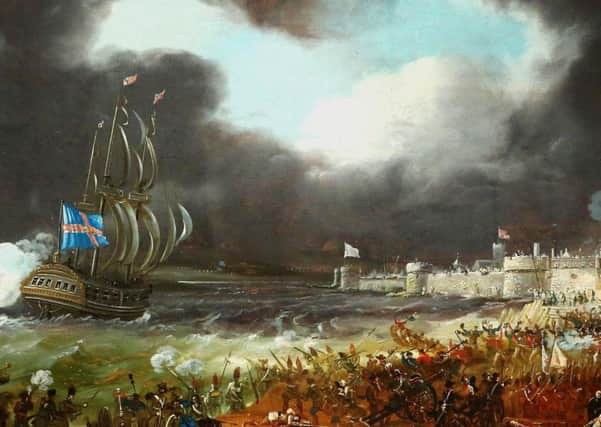Standing strong: Derry’s Walls at 400


The oldest and perhaps best-preserved city walls in Europe, work to build the famous Derry walls began in 1613 to protect the Protestant settlers of what would soon become the Plantation of Ulster’s commercial hub.
The unbreached and still-standing stout stone walls that gave birth to Londonderry’s Maiden City moniker were completed in 1619 and have withstood of course the famous Great Siege of 1689, as well as several rebellions and the more recent conflict of the Troubles.
Advertisement
Hide AdAdvertisement
Hide AdBuilt by an association of London-based merchants known as the London Companies who would go on to form the Honourable the Irish Society, the walls remain a symbol of both the completion of the Tudor conquest of Ireland and the indomitable spirit of the early Protestant planters who made Ulster their home in the era following the Nine Years War.
The connection between Londonderry and London, reflected in the city’s official name, dates back precisely to the period when the walls were first built.
The London Companies, in return for a vast swathe of land surrounding the existing settlement of Derry, had been tasked with rebuilding and then fortifying the town after it had been razed during a failed rebellion led by Cahir O’Doherty in 1608.
The city had been occupied during the Nine Years War by Sir Henry Dowcra, who had ordered the construction of temporary fortifications built of earth and timber.
Advertisement
Hide AdAdvertisement
Hide AdBut the destruction wrought by the O’Doherty forces in 1608 prompted the construction of a more permanent and secure structure to protect the newly chartered city of London-derry.
Designed by Sir Edward Doddington and constructed under the instruction of a master builder from London, Peter Benson, the work was fully complete by 1619, save for some minor additions in later years.
The new walls, built short and squat in the style developed in Italy in the 16th century to repel artillery fire, would prove their worth before long when the city was besieged.
The walls occupy a permanent place in the Ulster imagination from the tales of heroism and hardship during the Great Siege of 1689, but the defences would be put to the test long before the Glorious Revolution brought William to the throne.
Advertisement
Hide AdAdvertisement
Hide AdThe fortified city of Londonderry was a useful refuge after the outbreak of the Irish Rebellion of 1641, an attempt by the Catholic gentry to seize control of the administrative apparatus in Ireland that would ultimately descend into perhaps the most destructive conflict in Irish history, the Confederate Wars.
And in 1649, the city endured an even longer but less famous siege than the Great Siege of 1689, when the newly formed Royalist and Parliamentary factions clashed.
The Parliamentary forces, under the command of Sir Charles Coote, had been embedded in Londonderry by March that year, when Royalist forces under Alexander Stewart arrived and placed the city under an eventually unsuccessful siege for five months.
Despite the efforts of Sir Coote’s city defenders in holding off the larger Royalist forces, it is the first major clash in the Williamite War in Ireland that is still commemorated each year by the Protestant community.
Advertisement
Hide AdAdvertisement
Hide AdEach year, the Apprentice Boys of Derry celebrate two important dates in the city’s history, both of which are linked inextricably with the famous city walls.
The first is the Shutting of the Gates, sometimes referred to as ‘Lundy’s Day’, which commemorates the decision made in early December 1678 by 13 young apprentices who seized the keys to the city and shut the gates to an advancing Catholic force intent on occupying the city.
The leader of the advancing force, Alexander MacDonnell, 3rd Earl of Antrim, decided an assault on the formidable Derry walls was unwise and withdrew.
The 105-day Great Siege truly began in April the following year.
Advertisement
Hide AdAdvertisement
Hide AdKing James himself appeared before the walls on April 18 to appeal directly to the city’s inhabitants, only to be greeted by a shot from the ‘Roaring Meg’ cannon and shouts of ‘No Surrender’.
The siege was long and brutal but the second date commemorated by the Apprentice Boys, the Relief of the city, would come on August 1 when the inhabitants of the city watched the besieging forces march away in defeat.
The walls were a crucial element in all these crucial moments in history.
Their place in the popular imagination has undoubtedly aided their preservation across four tumultuous centuries.
Advertisement
Hide AdAdvertisement
Hide AdThe Honourable the Irish Society, the original builders of the famous monument, still own the city walls and continue to take a benevolent interest in their preservation.
The iconic and remarkably unchanged 17th century structure continues to prove a boon to Northern Ireland’s second city, as tourists from near and far flock to the famous walled city, the last of its kind remaining in Europe.
l Morning View, page 18